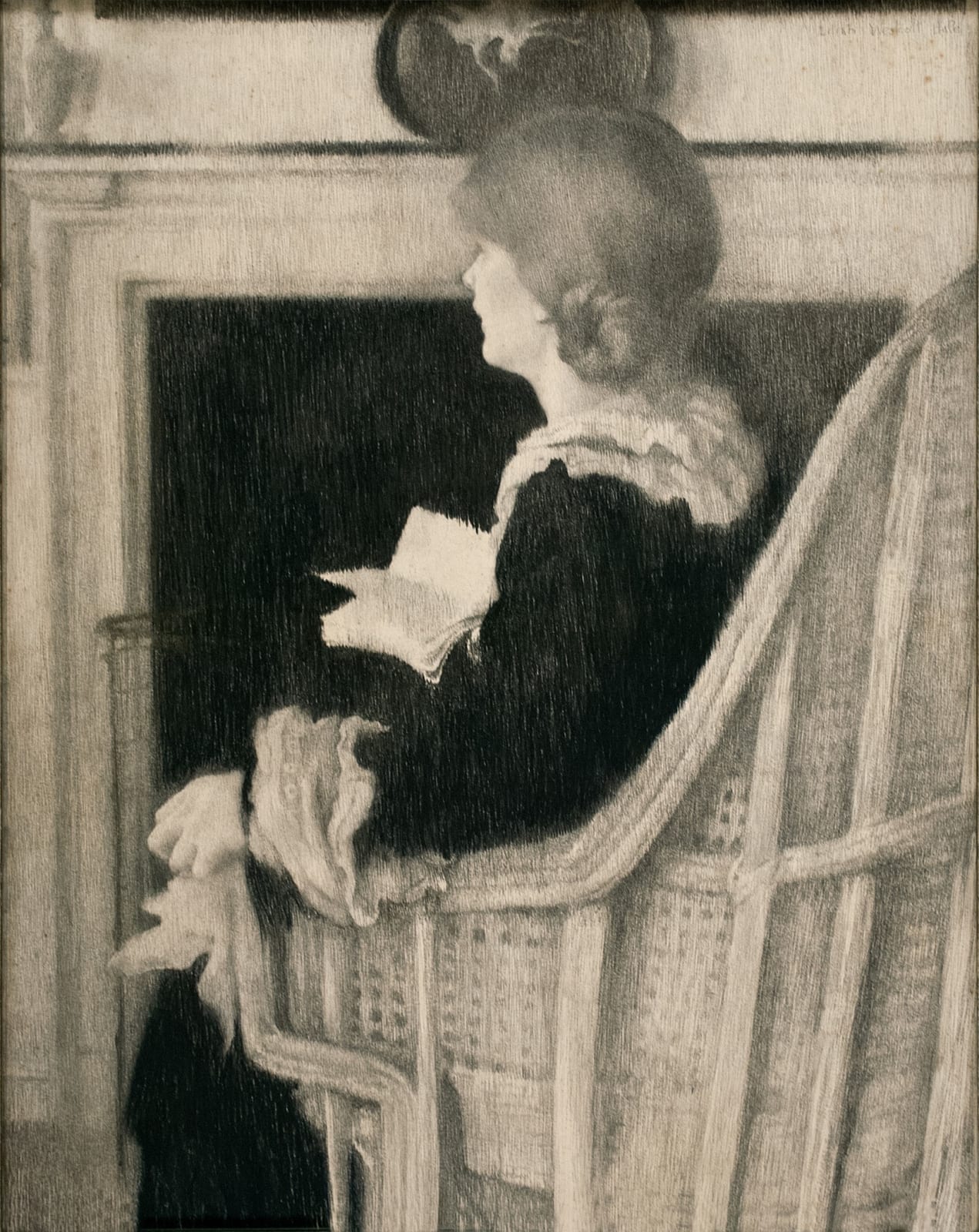Lilian Westcott Hale 1880-1963
Framed dimensions: 33 3/8 x 27 5/8 inches
Lilian Westcott Hale showed an exceptional talent for and dedication to art from a very early age. She first began studying at the Hartford Art School in Connecticut where she caught the eye of the important teacher and Impressionist painter, William Merritt Chase. Hale went on to attend his summer school at Shinnecock, and indeed, Chase was so impressed with the young student that he was “afraid to interfere with what she was doing.”28 In 1900, she won a scholarship to begin studying at the Museum School in Boston. Her instructors included Edmund C. Tarbell and Philip Leslie Hale, whom she fell in love with and married in 1902.
The choice to marry Philip was not an easy one, particularly at a time when so many women artists believed that for “the vast majority of women it is impossible to practice art after marriage.”29 As Hale carefully weighed the decision, her sister encouraged her, saying: “Mr. Hale seems a man very congenial in his tastes to yours, and I do not see why [by] loving and marrying him you would break your vow of everlasting faithfulness to your work.”30 While she ultimately accepted his proposal and the marriage was a happy one, it was not without its complications. Philip was very supportive of Hale’s painting career, but as her talent quickly outshone his and her work became more successful, tensions arose; she sought to dispel them by overcompensating in her deference towards her husband, addressing him in a way that still “suggested the relationship of master and pupil.”31 In 1908, their daughter Nancy was born, and Hale became increasingly occupied with the responsibilities of motherhood. She moved her studio out of the Fenway Studio Building and into their home. Nevertheless, she managed to balance her maternal duties with her art; her daughter became one of her primary subjects, which enabled her to both mind her child and produce work at the same time.
Hale painted portraits, figure studies, still lifes, and landscapes; moreover, she also produced finished charcoal drawings which she often displayed alongside her paintings and considered them to be of equal importance. She developed a sensitive and delicate style, and her drawings are especially extraordinary in that regard. As one contemporary reviewer remarked, “But in her drawing, it is safe to say that she is without a rival. The delicacy of her black and white is indescribable; the whiteness of the white, and the paleness of the gray are notable always, but the subtlety of the two as they become one, tests the eye of the average observer.”32 Her drawing technique is also particularly singular—the subtle modulation of tone is created by parallel vertical lines, layered with varying density, which contrast with the white of the untouched paper.
Completed in 1924, Book of Verses is a superb exampe of Hale’s mature drawing style. The entirety of the image is fully rendered with an extraordinary breadth of tones, ranging from the pale and delicate values in the sitter’s face and hair to a deep rich charcoal gray in her dress. While the most careful attention is given to the young woman’s face and hand, including her elaborate ruffed collar and sleeve, the background is also rendered with considerable detail—Hale has deliberately drawn in the woven pattern of the wicker chair and even faintly delineated the molding on the mantelpiece along with the sparse objects arranged above it. While the identity of the sitter in Book of Verses is unknown, it most likely depicts Hale’s daughter Nancy, who would have been sixteen at the time. Nancy had continued to serve as a model for her mother as she grew older, however she often asked to be allowed to read while posing, so that she could pursue her favorite pastime during the long hours that it took to complete such a finished drawing. Here, she looks up from the book in her hand with her mouth slightly open, perhaps reciting a passage from the “book of verses” that she has just been reading. Aptly titled, Book of Verses possesses a visual poetry of its own, and this exquisite work of art amply demonstrates the mature mastery of Hale’s unique drawing style.
Provenance
The artist;
Vose Galleries, Boston, (unknown inventory no.), ca. April 1924, eventually returned to the artist;
Private collection, Dover, Massachusetts;
Vose Galleries, Boston, inventory no. 32693, December 1998;
Private collection, Boston;
Private collection, New York until 2025
Exhibitions
(Possibly) Pennsylvania Academy of the Fine Arts, 23rd Annual Watercolor Exhibition, November 8- December 13, 1925.
(Possibly) Concord Art Association, Massachusetts, 9th Annual Exhibition, May 3-July 1, 1925.
The Art Institute of Chicago, Sixth International Watercolor Exhibition, May 3-30, 1926, no. 87, as Book of Verses.
Avery Galleries, Bryn Mawr, Pennsylvania, American Women Artists, 1860-1960, October 13-November 10, 2017.
Literature
Avery Galleries, Bryn Mawr, Pennsylvania, American Women Artists, 1860-1960, exhibition catalogue (2017), pp. 40-43.



